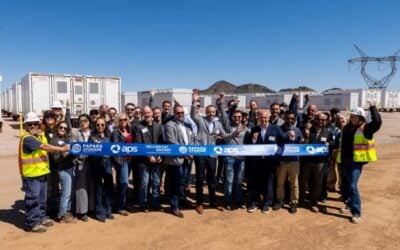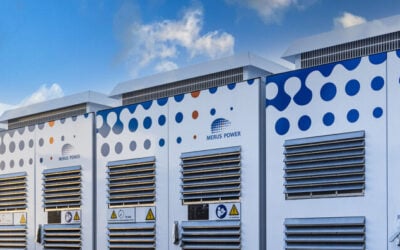Enphase's AC battery, which the company is looking to gradually begin rolling out towards the end of this year. Image: Enphase.
Residential solar will be sold almost exclusively in bundled energy systems that include storage and energy management components within a “couple of years” the CEO of Enphase has predicted, calling the total system the "future of energy".
In a recent interview with PV Tech Storage, Paul Nahi also said that a robust economic case for US households to use storage does not yet exist and that using storage at domestic level for backup in the US has been overestimated as a market driver. Net metering exists in most states of the US, paying those with solar on their rooftops for the electricity their systems feed into the grid.
Enjoy 12 months of exclusive analysis
- Regular insight and analysis of the industry’s biggest developments
- In-depth interviews with the industry’s leading figures
- Annual digital subscription to the PV Tech Power journal
- Discounts on Solar Media’s portfolio of events, in-person and virtual
In contrast, countries where storage is beginning to gain traction at the domestic level include Germany, where subsidies have fallen away to the point where PV system owners are better off using batteries to store and ‘self-consume’ their own power, and island or remote regions where the cost of electricity is already high.
However, Nahi said, the correct market conditions to reward and recognise the value of storage may only be a short distance away in the near future, beginning with forward-thinking strides taken in regions such as Hawaii and Australia. Both of those areas have high energy costs and low energy security due to their remote or island locations and their reliance on imported fuels.
“I think you should look at Hawaii as a little bit of a canary in a coal mine if you will. It’s a contained grid, it’s small, with a very high penetration of solar, so they’re seeing things before a lot of other places will see them,” Nahi said.
Similarly, some regions of Australia are trying new ways of accommodating more solar rooftops while maintaining grid stability. Nahi gave the example of Queensland, where solar PV users are being actively encouraged to operate their systems off-grid. Households get cheaper electricity by generating and using it themselves, while the grid operator does not have to worry about fluctuating supply going into the network and causing instability.
An Enphase installation in Australia. The economics of energy in Australia already make it an interesting market for solar-plus-storage. Image: Enphase.
“
In the future I don’t believe you’ll buy a solar system on its own, and I’m not talking about in five years’ time, I’m talking about in just a couple of years.
In another Australian region, New South Wales, the locally applicable feed-in tariff (FiT) rate has dropped significantly while utility retail rates remain high. This means PV users in that area can ‘arbitrage’ their power costs by storing and using self-generated electricity, rather than accepting a small FiT incentive that is far outweighed by the cost of buying power. It would make sense for North America’s ‘canary in a coal mine’ to do something similar, Nahi argued, and said that he believes much of the rest of the US may follow. Sustainability group the Rocky Mountain Institute has similarly said that it expects many parts of the US to start adopting time-of-use electricity rates in the near future.
“There is talk about something like that zero export rule occurring in Hawaii as well, to help stabilise the grid while letting people do all the solar they want. The demand for solar [in Hawaii] is very high because the cost of energy is very, very high,” Nahi said. “Which would immediately create a market for storage in Hawaii. It hasn’t happened yet, but that would resolve that problem.”
In the meantime, the US is lagging in seeing market-driven business cases for storage emerge, with companies including SunPower and SolarCity offering batteries to some residential customers, but with the exception of a handful of projects that look to combine a number of units to form aggregated virtual power plants, these energy storage devices are being deployed as backup in cases of power outages. While Nahi acknowledged that backup makes sense, he said its role in persuading people to part with cash for energy storage systems might not be as prominent as some would hope.
“Does backup have that much utility? I think backup is being way overblown as a capability. If you really need backup, the problem is, 7kWh, 20kWh isn’t gonna do it. If you really want backup, you get a generator. There are companies that provide natural gas or diesel generators that are very inexpensive, and can truly keep you backed up indefinitely. That’s not to say there isn’t a market for battery backup [but] it’s going to be relatively small.”
According to Nahi, the benefits of storage and solar to play an active role not only in providing generation and load when it is needed but also to keep grids balanced are not yet obvious to consumers. However, he said, he expects evolving business models for utilities, with supply and demand kept balanced through a variety of flexible resources and the leveraging of more and more accurate data taken from around the network, to lead to a completely different kind of market for both technologies before long.
“In the future I don’t believe you’ll buy a solar system on its own, and I’m not talking about in five years’ time, I’m talking about in just a couple of years,” he said.
“I think what’s going to happen is that you’ll buy an energy system. That energy system will consist of storage, generation – solar obviously – load management and an app, all leveraged through big data analytics in the cloud. So that the profile of that particular system is adjusted for the highest financial benefit to the consumer and in concert with whatever grid requirements are at the time.
“So you take more responsibility for storage, generation and usage, but you do it in such a way that is less expensive than pure utility energy and the utility has access to what it needs to, to make sure that it plays well on the grid. That to me is the future of energy.”
The company believes the "future of energy" will see PV, storage and monitoring combined with data and analytics to form energy systems in which the grid still has a vital role to play. Image: Enphase.






